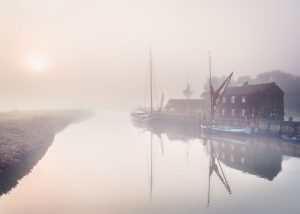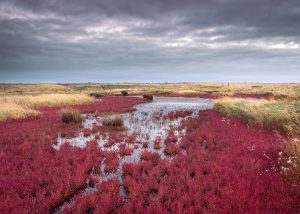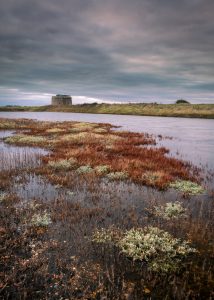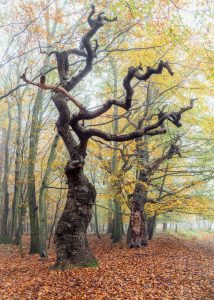Autumn is one of my favourite times of the year. The changing colours, the fresh mornings with a hint of mist and the fact that the sun rises at a much more civilised hour, all make this a popular time to get out with the camera.
Many of us think of the woods when we think of autumn locations to photograph but I am going to give you a few more ideas that work particularly well on the Suffolk Coast. (I will talk about woodland too!)
What to photograph and where.
There are two things that are synonymous with autumn photography. The first is colour and the second is mist. Both of these are available in the woods but they are also available in other locations too.
Rivers and Estuaries
Still misty mornings are a great time to visit the river. If the tide is high there will be plenty of reflections and you can get some really moody images using the boats appearing out of the mist.
 When you reach the edge of the river bank on a misty morning it is tempting to point the camera across the river and just focus on the reflections and the tranquility of the morning. But if it is too misty you are in danger of having an image that is devoid of colour. If this is the case try to pick out some colour in the landscape to focus on, a bright fishing boat as in this image at Felixstowe, or wait for the sun to start burning off the mist which will give some lovely atmosphere.
When you reach the edge of the river bank on a misty morning it is tempting to point the camera across the river and just focus on the reflections and the tranquility of the morning. But if it is too misty you are in danger of having an image that is devoid of colour. If this is the case try to pick out some colour in the landscape to focus on, a bright fishing boat as in this image at Felixstowe, or wait for the sun to start burning off the mist which will give some lovely atmosphere. 
This image at Snape was taken just as the sun began to burn off the mist. Prior to this moment the landscape was very flat and although it was atmospheric there was no colour in the scene. As soon as the sun began to show the mood changed and the image took on a much warmer feel. I had to over expose this image by about 1 stop so that the mist didn’t look overly grey, but I also had to be careful not to blow out the emerging sun. I found an exposure that was a good balance and then brought out some of the shadow areas in post processing.
 In this image at shingle street the mist became more intense as the sun rose and began to warm the water. This phenomenon gives a lovely atmospheric effect as the mist rises from the water.
In this image at shingle street the mist became more intense as the sun rose and began to warm the water. This phenomenon gives a lovely atmospheric effect as the mist rises from the water.
 If there is no mist present rivers and estuaries will also give you some wonderful autumn colours. Glassworts, the low growing fleshy plants that often edge the salt marsh turn a vibrant red or rusty colour as winter approaches. If you look carefully you will find carpets of red along the estuaries which you can use to give your river images some autumnal colour. The plants don’t stay vibrant red for long, they eventually fade to a rusty brown, but they can be found along the salt marsh in Suffolk from Walberswick to the Stour. The image on the right hasn’t been saturated in any way, these plants really are that red!
If there is no mist present rivers and estuaries will also give you some wonderful autumn colours. Glassworts, the low growing fleshy plants that often edge the salt marsh turn a vibrant red or rusty colour as winter approaches. If you look carefully you will find carpets of red along the estuaries which you can use to give your river images some autumnal colour. The plants don’t stay vibrant red for long, they eventually fade to a rusty brown, but they can be found along the salt marsh in Suffolk from Walberswick to the Stour. The image on the right hasn’t been saturated in any way, these plants really are that red!
 My images often rely on prominent foregrounds for their composition and in the autumn I love using areas of vegetation to lead the eye into the scene. The image on the left was taken looking across one of the lagoons which sit between the sea and the adjacent farmland at East Lane in Bawdsey. The rusty red glassworts mix with other foliage to give a wonderful carpet of colour in the foreground to lead the eye to the Martello tower on the horizon.
My images often rely on prominent foregrounds for their composition and in the autumn I love using areas of vegetation to lead the eye into the scene. The image on the left was taken looking across one of the lagoons which sit between the sea and the adjacent farmland at East Lane in Bawdsey. The rusty red glassworts mix with other foliage to give a wonderful carpet of colour in the foreground to lead the eye to the Martello tower on the horizon.
Woodlands
 Suffolk has some amazing and diverse woodland areas. As autumn approaches they are some of my favourite places to explore. You can photograph woodlands in any weather conditions but the best times to visit are on misty mornings or grey or drizzly days when the light is diffused and there are no harsh shadows around. I actually prefer misty or drizzly days because the water really helps to saturate and bring our the autumnal colours.
Suffolk has some amazing and diverse woodland areas. As autumn approaches they are some of my favourite places to explore. You can photograph woodlands in any weather conditions but the best times to visit are on misty mornings or grey or drizzly days when the light is diffused and there are no harsh shadows around. I actually prefer misty or drizzly days because the water really helps to saturate and bring our the autumnal colours.
When shooting in woods it often pays to use a polariser which will help to eliminate the glare that can bounce of wet foliage. It will also help to saturate the autumn colours.
The key to woodland photography is simplicity. Begin by looking for characters. Find some interesting trees that have a quirky shape or intact is a good way with their neighbours. Then look to see how you can compose a shot around your character. Try to keep things simple – less is always more. Many people try to include too much in the scene, but be ruthless and keep your image focused.
The image on the right works because the shape of the tree immediately grabs your attention. The mist helps to simplify the scene and makes the rest of the wood recede into the distance.
 This next image, called dancing trees, also works because it focuses on the interaction between two elements within the frame. They become the main focus of the image and the background recedes into the mist.
This next image, called dancing trees, also works because it focuses on the interaction between two elements within the frame. They become the main focus of the image and the background recedes into the mist.
Post processing plays a huge part in the success of your woodland images. I always process my images in sections using masks which I generate either with brushes or radial gradients. I think of my image as a series of layers and the aim is to lead the viewers eye through the image using these layers. So in this shot the dancing trees become the most prominent part of the image and everything else fades into the distance. I use some negative clarity and negative dehaze on the background to help soften the image and make the lead characters stand out.
The main piece of advice is to get out and take lots of photographs. Look for compositions when the weather is not ideal then you can go back and really make good use of your time when the conditions are perfect.
Find out more
If you would like to read a bit more about woodland photography in autumn then check out my Shoot for the Moon newsletter which covers autumn woodlands in greater detail.
I am running some woodland photography workshops this autumn in some of my favourite Suffolk woodlands. If you would like to come along please check out my workshops below: